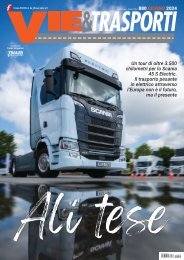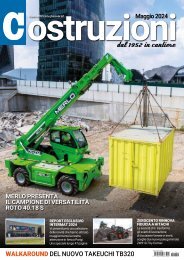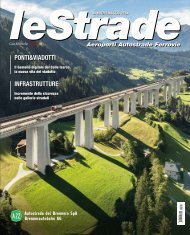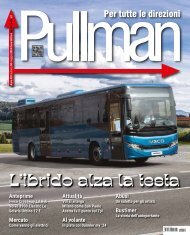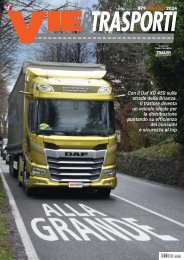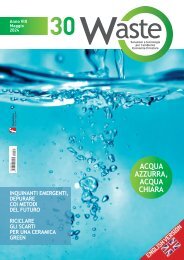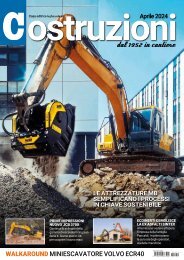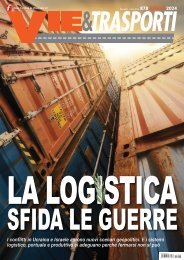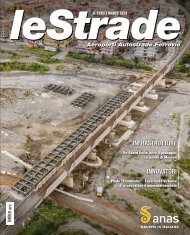leStrade n. 1956 aprile 2024
INFRASTRUTTURE Milano Serravalle Milano Tangenziali La sicurezza in tempo reale GALLERIE La Realtà Virtuale “avanza” nelle gallerie BBT
INFRASTRUTTURE
Milano Serravalle Milano Tangenziali La sicurezza in tempo reale
GALLERIE
La Realtà Virtuale “avanza” nelle gallerie BBT
- No tags were found...
Create successful ePaper yourself
Turn your PDF publications into a flip-book with our unique Google optimized e-Paper software.
to, questa calibrazione può riguardare l’identificazione<br />
di parametri che governano l’evoluzione<br />
della rigidezza, leggi di evoluzione di creep e ritiro,<br />
danneggiamento, corrosione o fatica.<br />
I dati vengono processati per eliminare dalle<br />
misure gli effetti dovuti a effetti transitori, quali<br />
variazioni di temperatura o carichi agenti. La<br />
calibrazione utilizza la serie completa delle misurazioni<br />
disponibili, al fine di continuare a migliorare<br />
le leggi che ne governano l’evoluzione<br />
nel tempo.<br />
La calibrazione di corto periodo identifica i parametri<br />
che governano rapide variazioni nei dati<br />
misurati. Esempi possono essere le caratteristiche<br />
termomeccaniche dei materiali, che governano<br />
la dipendenza del comportamento della<br />
struttura al variare della temperatura (es. spostamenti<br />
dovuti a gradienti di temperatura), ma<br />
anche carichi agenti (es. da traffico), che causa-<br />
Fig. 14: Identificazione delle frequenze proprie per una campata del viadotto dei Parchi.<br />
Fig. 14: Identification of the natural frequencies for a span of the Parchi Viaduct.<br />
Fig. 13: Confronto tra<br />
i risultati del gemello digitale<br />
e prove di carico sul viadotto<br />
dei Parchi, per differenti<br />
altezze delle pile.<br />
Fig. 13: Comparison between<br />
the results of the digital twin<br />
and load tests on the Parchi<br />
Viaduct, for different pier<br />
heights.<br />
Fig. 15: Esempio di<br />
ricostruzione della deformata<br />
mediante dati inclinometrici<br />
per il viadotto Forlanini.<br />
Fig. 15: Example of<br />
deformation reconstruction<br />
using inclinometric data for<br />
the Forlanini Viaduct.<br />
no deformazioni e spostamenti repentini e solitamente<br />
reversibili (elastici), ma anche scenari<br />
di danneggiamento improvviso, che la piattaforma<br />
è predisposta per cogliere e quantificare con<br />
precisione.<br />
Alcuni risultati<br />
Al fine di validare i modelli di calcolo, è stata effettuata<br />
la simulazione delle prove di carico disponibili.<br />
Per il viadotto dei Parchi, queste sono<br />
state eseguite durante il mese di maggio 2021.<br />
Durante le suddette prove, diverse campate del<br />
viadotto sono state caricate con un numero massimo<br />
di sei autocarri del peso di circa 30-32 t<br />
ciascuno, disposti come raffigurati in figura. Gli<br />
spostamenti dell’impalcato sono stati rilevati mediante<br />
rilievo topografico.<br />
Le simulazioni numeriche sono state effettuate<br />
utilizzando il modello precedentemente descritto,<br />
integrato nel gemello digitale.<br />
In particolare, si è voluto descrivere precisamente<br />
la posizione degli autocarri applicando le impronte<br />
degli pneumatici direttamente sull’impalcato,<br />
in considerazione anche degli effetti di<br />
ripartizione nello strato di asfalto come previsto<br />
dalla normativa.<br />
Le simulazioni hanno tenuto conto delle differenti<br />
altezze delle pile corrispondenti alle campate<br />
analizzate, introducendo due nuove altezze,<br />
pari a 15 metri e 9 metri. I risultati mostrano<br />
un incremento di circa il 20% in termini di freccia<br />
massima, a parità di carico, in corrispondenza<br />
delle pile più alte.<br />
Le simulazioni hanno mostrato un’ottima aderenza<br />
al comportamento reale della struttura, con<br />
discrepanze trascurabili sia in termini di massima<br />
inflessione dell’impalcato, sia in termini dell’andamento<br />
degli spostamenti.<br />
Il sistema in fibra ottica distribuita installato sul<br />
viadotto dei Parchi permette l’acquisizione dei<br />
valori di strain rate (o derivata della deformazione<br />
nel tempo) e valori di strain (deformazione o<br />
allungamento della fibra).<br />
I valori di strain rate vengono processati automaticamente<br />
dal sistema, consentendo la caratterizzazione<br />
dinamica e l’identificazione dei parame-<br />
English Version<br />
behavior of the structure, particularly the interaction between<br />
structural elements installed at different times (for<br />
example, in the expansion interventions of the Parchi viaduct<br />
or the Tortona viaduct). The modeling also takes into<br />
account the thermomechanical properties of the materials<br />
used, allowing the description of effects induced by temperature<br />
variation.<br />
Taking as a reference the FEM model created for the Parchi<br />
viaduct, analogous to the calculation procedures carried<br />
out in the design phase of the asset, the combined behavior<br />
of three successive spans is analyzed, accurately modeling<br />
the interactions between them.<br />
The deck, the piers, and the foundations have been modeled<br />
using 20-node brick finite elements with quadratic<br />
shape functions. The Dywidag bars and the tensioning tendons<br />
have been modeled using specific elements capable<br />
of supporting purely axial actions.<br />
The model was developed to support different pier heights,<br />
in accordance with what was done in the design phase<br />
and with the real characteristics of the work. In particular,<br />
models were created for piers of heights of 7.5, 12.5,<br />
and 17.5 meters.<br />
For the purpose of performing checks according to regulations<br />
and calculating the utilization factor of the structure,<br />
the internal actions are calculated by the platform through<br />
numerical integration of the stresses of the three-dimensional<br />
brick elements.<br />
Measures post-processing<br />
Starting from the initial model, a fundamental character-<br />
istic of the digital twin is the ability to adapt its properties<br />
based on the actual behavior of the structure, promptly<br />
identifying the onset of any damage. The goal of the digital<br />
twin is to automatically minimize the discrepancy between<br />
the calculation model and the measured data, in<br />
order to obtain a reliable evaluation of the stress state of<br />
the structure, based on its entire load history, and its behavior<br />
under acting loads.<br />
The digital twin thus performs the updating and automatic<br />
calibration of the model based on the monitoring data that<br />
are continuously acquired. The solution uses advanced<br />
techniques for real-time inverse analysis (or back-analysis)<br />
for the calibration of the digital twin, aimed at minimizing<br />
the discrepancy between the data measured by<br />
sensors installed on the structure, and the results of numerical<br />
simulations. In particular, the platform automatically<br />
and continuously carries out calibration procedures<br />
to identify any unknown structural parameter (or one for<br />
which there is significant uncertainty) that governs the results<br />
of the simulation, using sophisticated iterative multi-objective<br />
optimization algorithms and advanced surrogate<br />
models, pre-trained through the results of thousands<br />
of numerical simulations. The parameters subject to calibration<br />
include, for example, the linear and nonlinear<br />
properties of materials, whose alteration may indicate the<br />
onset of structural damage.<br />
The dynamic properties of the structure are identified<br />
through Operational Modal Analysis (OMA), which allows<br />
for the determination of natural frequencies, modal shapes,<br />
and damping using structural response data obtained under<br />
Infrastrutture&Mobilità<br />
46 4/<strong>2024</strong> <strong>leStrade</strong><br />
<strong>leStrade</strong> 4/<strong>2024</strong> 47






